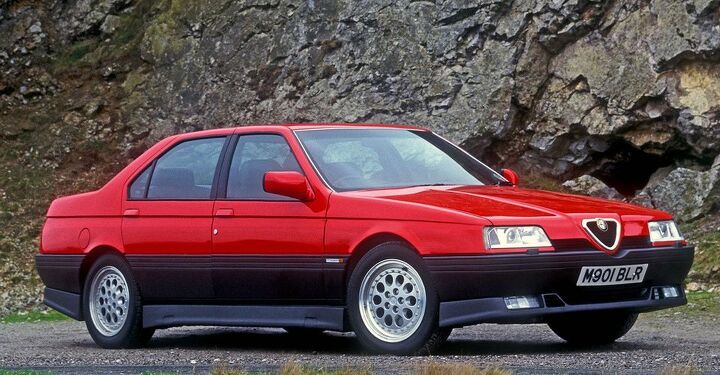Rare Rides: The 1994 Alfa Romeo 164, Saab-adjacent Sedan

Rare Rides has featured many an Alfa Romeo previously, spanning several decades from the Fifties to present day. Among all the featured cars from the illustrious marque, only one was a sedan.
That figure grows to two today with the lovely, stylish, and luxurious 164.
The 164 was Alfa Romeo’s flagship sedan, and a replacement for the rather dated Alfa 6 which was in production since 1979. The rear-drive 6 saw its last model year in 1986, as the much more modern and front-drive 164 was ready for ’87.
In development since 1978, the 164 was part of a four-company joint effort to produce a safe, stylish, and luxurious executive car for the world market. Fiat, Alfa Romeo, Lancia, and Saab signed a cooperative agreement and developed the Type Four platform. Said platform produced today’s 164, the Lancia Thema featured here previously, the Fiat Croma, and the car with which our readers are most likely familiar, the Saab 9000.
The manufacturers pooled their resources to create a flexible sedan that could take on not only mass-market competition from Ford and Opel/Vauxhall but also luxury offerings like the Mercedes-Benz E-Class and 5-Series. By the time the 164 debuted, formerly independent Alfa was a part of the Fiat group. It was the last of the four cars to enter production, and maintained the most unique styling: The other cars shared door panels, but the Alfa got its own. 164 was also the first Alfa to use considerable input from computers in its design, for real computer-aided passion in a pre-internet sense.
The 164’s angular, lovely lines and heckblende were shaped by Enrico Fumia at Pininfarina, who would go on to design the Nineties GTV and Maserati 3200GT. Engines ranged from a 2.0-liter Twin Spark inline-four to a 3.0-liter V6 of Alfa Romeo’s own design. In the middle were a 2.0 turbocharged Fiat engine, and a 2.0 turbocharged V6 from Alfa. Economy-minded customers could have a 2.5-liter diesel from Sofim, which was primarily used in Renault vans. Transmissions on offer were four-speed if automatic, and five or six speeds if manual. Though the vast majority of 164s were front-drive, Alfa introduced an all-wheel-drive Q4 version later in its run, with a drive system developed by Steyr-Puch. Q4s could send up to 100 percent of power to the rear wheels if necessary, and all were equipped with the 3.0-liter V6.
In North America, the 164’s breadth was a bit more limited. All examples had the 3.0 V6 engine, available in 210 horsepower in the base LS trim, or 230 horses in the S. Ailing as a domestic offering, the 164 was the final product offering of Alfa North America in 1995. At that point, the brand went dormant on this continent until the arrival of the 8C circa 2008. Elsewhere, the 164 continued in production through 1998. It was replaced by the less successful and less good-looking 166.
Today’s Rare Ride hails from 1994 and is a black-on-black example with an automatic. With 80,000 miles it asks $8,995 which is quite dear.
[Images: Alfa Romeo]

Interested in lots of cars and their various historical contexts. Started writing articles for TTAC in late 2016, when my first posts were QOTDs. From there I started a few new series like Rare Rides, Buy/Drive/Burn, Abandoned History, and most recently Rare Rides Icons. Operating from a home base in Cincinnati, Ohio, a relative auto journalist dead zone. Many of my articles are prompted by something I'll see on social media that sparks my interest and causes me to research. Finding articles and information from the early days of the internet and beyond that covers the little details lost to time: trim packages, color and wheel choices, interior fabrics. Beyond those, I'm fascinated by automotive industry experiments, both failures and successes. Lately I've taken an interest in AI, and generating "what if" type images for car models long dead. Reincarnating a modern Toyota Paseo, Lincoln Mark IX, or Isuzu Trooper through a text prompt is fun. Fun to post them on Twitter too, and watch people overreact. To that end, the social media I use most is Twitter, @CoreyLewis86. I also contribute pieces for Forbes Wheels and Forbes Home.
More by Corey Lewis
Latest Car Reviews
Read moreLatest Product Reviews
Read moreRecent Comments
- Spectator Wild to me the US sent like $100B overseas for other peoples wars while we clammer over .1% of that money being used to promote EVs in our country.
- Spectator got a pic of that 27 inch screen? That sounds massive!
- MaintenanceCosts "And with ANY car, always budget for maintenance."The question is whether you have to budget a thousand bucks (or euro) a year, or a quarter of your income.
- FreedMike The NASCAR race was a dandy. That finish…
- EBFlex It’s ironic that the typical low IQ big government simps are all over this yet we’re completely silent when oil companies took massive losses during Covid. Funny how that’s fine but profits aren’t. These people have no idea how business works.





































Comments
Join the conversation
There's a Wheeler Dealers episode on one of these that, I'm inferring, some of you would like watching, if you haven't already: www.motortrendondemand.com/detail/1991-alfa-romeo-164l/108979/
I had a 1995 164 Quadrifoglio (hence my avatar), the last of the breed. Loved, loved LOVED that car, but the maintenance and repairs ate me alive. I won't list them all here, but... It's an interference engine design, and the DOHC heads (on the '94 and '95 models) had a bad habit of eating the teeth off the timing belt. When that happened to me, it was a $6,800 rebuild. 24 bent valves is no fun at all. Like any good Italian mistress, the 164 is a beauty what will leave you shattered and penniless; and you'll be glad for it. I was happy to have it, and happier to see it go to the next victim.